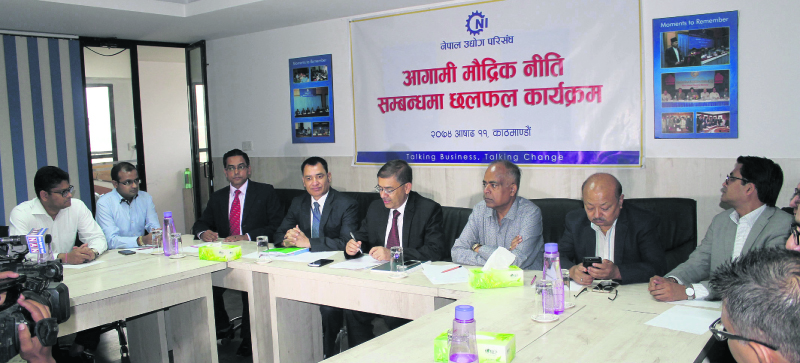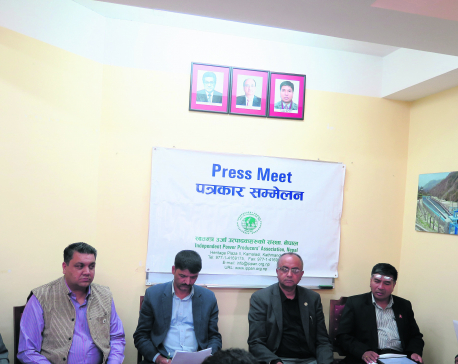
OR
Ending credit crunch problem
CNI for channelizing govt treasury surplus into banking system
Published On: June 26, 2017 12:40 AM NPT By: Republica | @RepublicaNepal

KATHMANDU, June 26: Private sector has suggested that the government and the Nepal Rastra Bank (NRB) directly funnel cash lying idle in the government coffer into the banking channel.
This channeling of certain cash from the government treasury, when there is excess surplus, into the banking sector can help to address the current credit crunch problem that the bank and financial institutions (BFIs) are facing due to mismatch in credit and deposit growth, according to business leaders.
Organizing an interaction in Kathmandu on Sunday, officials of the Confederation of Nepalese Industries (CNI), the apex body of Nepali industrialists, urged the central bank to prioritize management of lendable funds in the upcoming monetary policy.
The CNI has said that one of the policies that the central bank should take to resolve the credit crunch problem is to channelize the fund from the treasury of the government if treasury surplus is higher than 10 percent of the total government budget.
For example, if the government budget size is Rs 1,048 billion and the treasury surplus is Rs 255 billion, the excess cash more than 10 percent of the budget, which stands at Rs 146 billion, will be channelized to bank and financial institutions.
The proposal comes in the wake of slowdown in deposit growth of bank and financial institutions partly due to low capital spending.“
"This policy is already being exercised in other countries including India. If this measure could be implemented in Nepal, it will help to resolve the current credit crunch problem and reduce financial intermediary coat," CNI President Haribhakta Sharma said in the interaction“. "Had this policy been in place, nearly Rs 146 billion would have already come into the banking system and the credit crunch problem would have been immediately resolved."
Because of the government's failure to expedite capital spending, nearly Rs 250 billion of cash is lying idle in its treasury as of last week, according to the NRB. Bankers say that the development fund, which would have pumped cash into the banking system if spent, was being locked in the government account due to the government's inability to boost the expenditure. The slow pace of development expenditure combined with slowdown in remittance inflow despite surge in credits has resulted into credit crunch.
According to CNI, the government can channelize such funds into the banking system either through deposit auction or bidding among BFIs or sending it to the refinance fund at the NRB which can later be extended as credits to productive sectors.
NRB is also positive toward the proposal made by the private sector body. While the central bank has not said publicly whether this arrangement can be introduced in the monetary policy, a senior NRB official has confirmed that the central bank would discuss the matter with the government.“
"The government seems to be positive toward addressing the current problem faced by the financial sector," Nara Bahadur Thapa, an executive director of the NRB, said. "We have held preliminary discussion on this issue with the government. Since the government is also facing difficulty when a large sum of cash is lying idle in the treasury, it is positive toward finding a way-out," he added.
CNI's to address credit crunch:
-Allowing commercial banks to open account in another bank so that highly liquid banks can deposit their excess liquid fund
-Extending the deadline of relaxation to deduct 50 percent of productive sector credits while calculation of CCD
-Increasing the size of refinance fund to at least Rs 100 billion
-Reducing cash reserve ratio of BFIs by one percentage point
-Scrapping 80 percent CCD ratio and implementing 20 percent liquidity ratio
-Increasing government expenditure or suspending internal borrowing when budget is unspent
You May Like This

Govt brings back environment fee lifted by K P Oli govt
KATHMANDU, April 4: A one percent fee that was being charged separately for environment services for hydropower project companies lifted by... Read More...

CNI urges govt to implement outcomes of infrastructure summit
KATHMANDU, Feb 23: Upbeat with the outcomes of the recently held 'Nepal Infrastructure Summit 2017', the Confederation of Nepalese Industries (CNI)... Read More...

New govt should follow course set by incumbent govt: PM Oli
KATHMANDU, July 30: Prime Minister KP Sharma Oli has said the next government was expected to follow the course set... Read More...










Just In
- NRB introduces cautiously flexible measures to address ongoing slowdown in various economic sectors
- Forced Covid-19 cremations: is it too late for redemption?
- NRB to provide collateral-free loans to foreign employment seekers
- NEB to publish Grade 12 results next week
- Body handover begins; Relatives remain dissatisfied with insurance, compensation amount
- NC defers its plan to join Koshi govt
- NRB to review microfinance loan interest rate
- 134 dead in floods and landslides since onset of monsoon this year








Leave A Comment